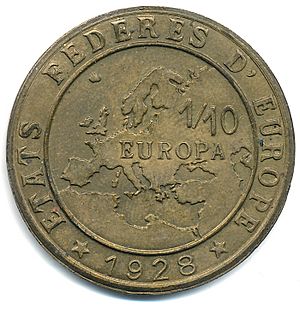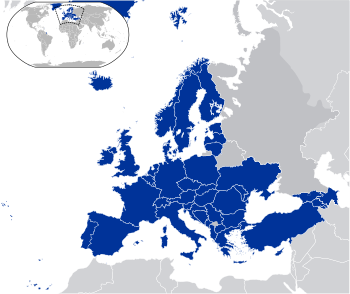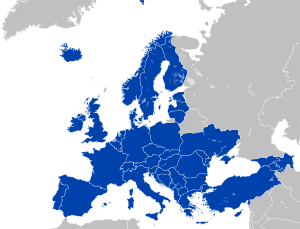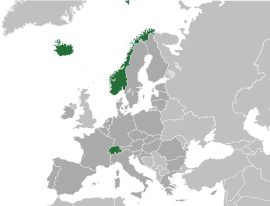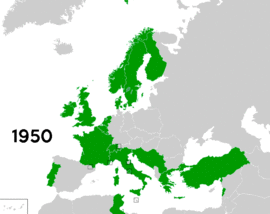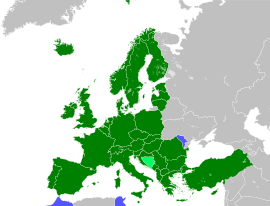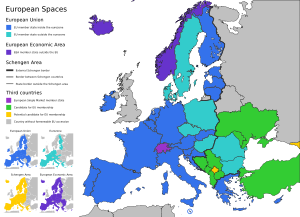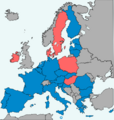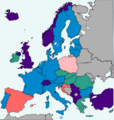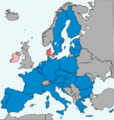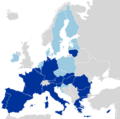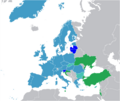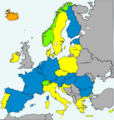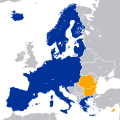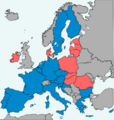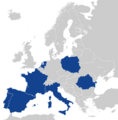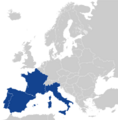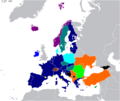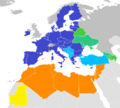European integration facts for kids
European integration is all about countries in Europe (or nearby) working together more closely. This can be in many ways: like sharing ideas, trading goods, making laws together, or even sharing culture. The main way this has happened is through the European Union (EU) and its rules.
Contents
- History: How Europe Started Working Together
- Why Countries Integrate: Different Ideas
- Groups Working for More Integration
- Different Ways Countries Work Together
- The Council of Europe: Protecting Rights
- European Political Community: Leaders Talking
- Organization for Security and Co-operation in Europe (OSCE)
- European Free Trade Association (EFTA)
- European Broadcasting Union (EBU)
- European Patent Convention (EPC)
- The European Communities: The Start of the EU
- The European Union: A Closer Partnership
- The Future of European Integration
- Beyond Europe: Global Connections
- Images for kids
- See also
History: How Europe Started Working Together
Long, long ago, the Roman Empire brought many parts of Europe and the Mediterranean Sea together. Later, other groups and empires also tried to unite parts of Europe, like the Holy Roman Empire or the Hanseatic League (a group of trading cities).
After the terrible First World War, people started thinking about how to prevent such big wars from happening again. Many thinkers and leaders believed that if European countries worked together, they could avoid future conflicts.
For example, in the 1920s, Richard von Coudenhove-Kalergi suggested a "Pan-Europa" idea, where European countries would unite. Later, in 1929, the French Prime Minister Aristide Briand spoke about creating a "federation of European nations" to help with trade and cooperation.
After World War II, Europe was devastated. Many people felt that extreme nationalism (thinking your country is the best and only one that matters) had caused the wars. This made the idea of working together even stronger. In 1946, Winston Churchill suggested a "United States of Europe" to bring peace and prosperity. He imagined France and Germany leading the way.
Why Countries Integrate: Different Ideas
People have different ideas about how countries should integrate:
- Federalism: This idea is like creating a "United States of Europe," where countries give up some of their power to a central European government. The goal is to stop wars and work as one big team.
- Functionalism: This idea suggests that countries should start by working together on specific, practical things, like coal and steel production. If they see success in these areas, they'll naturally want to work together on more things.
- Intergovernmentalism: This idea says that countries (their governments) are still the most important players. They work together when it's good for them, but they keep most of their power.
These ideas have helped shape how Europe has come together over the years.
Groups Working for More Integration
Many groups and organizations support the idea of a more united Europe. Some of these include:
- The Union of European Federalists (UEF)
- The European Movement International
- The European Federalist Party
- Volt Europa
These groups work to encourage European countries to cooperate even more closely.
Different Ways Countries Work Together
Countries in Europe are part of many different groups and agreements. Some countries are part of more groups than others.
Common Groups for EU Countries
All countries that are part of the European Union (EU) are also members of many other important groups, such as:
- The Organization for Security and Co-operation in Europe (OSCE)
- The European Political Community (EPC)
- The Council of Europe (CoE)
- European Olympic Committees (EOC)
- The European Union Customs Union (EUCU)
Working Together in Specific Regions
Some areas in Europe have their own special ways of working together:
Nordic Countries
The Nordic Council helps countries like Denmark, Finland, Iceland, Norway, and Sweden work together. They even have a Nordic Passport Union, which means citizens can travel between these countries without needing a passport!
Baltic Sea Region
Countries around the Baltic Sea, like Estonia, Latvia, and Lithuania, have groups like the Baltic Assembly to promote cooperation. There was also a Baltic Free Trade Area (BAFTA) for easier trade, but it ended when these countries joined the EU.
Low Countries (Benelux)
Belgium, the Netherlands, and Luxembourg formed the Benelux economic and political union. They even had a customs union before the EU existed, making trade easier between them.
Black Sea Region
Countries around the Black Sea have groups like the Organization of the Black Sea Economic Cooperation (BSEC) to encourage peace, stability, and trade.
United Kingdom and Ireland
The British–Irish Council helps the UK and Ireland work together. They also have a Common Travel Area, which means citizens can travel freely between Ireland, the UK, and some nearby islands without passports.
Central Europe
The Visegrád Group brings together the Czech Republic, Hungary, Poland, and Slovakia for cooperation. The Central European Free Trade Agreement (CEFTA) helps countries in Central Europe and the Balkans trade more easily, often as a step towards joining the EU.
Danube Region
Countries along the Danube River work together through the EU Strategy for the Danube Region to improve cooperation and development.
The Council of Europe: Protecting Rights
The Council of Europe was created in 1949, after World War II, to help bring peace and protect human rights. Its biggest achievement is the European Convention on Human Rights, which protects basic rights and freedoms across Europe. It also has a special court, the European Court of Human Rights, where people can go if they feel their rights have been violated.
The Council of Europe helps countries work together on many things, like fighting crime, protecting cultural sites, and recognizing university degrees. Most European countries are members, working together on shared values like human rights and democracy.
European Political Community: Leaders Talking
The European Political Community (EPC) is a new meeting place for leaders from many European countries. They get together to talk about important political and strategic ideas for the future of Europe. The first big meeting was in Prague in 2022.
Organization for Security and Co-operation in Europe (OSCE)
The Organization for Security and Co-operation in Europe (OSCE) is a large group that works to keep Europe stable and secure. It helps prevent conflicts, deals with economic and environmental threats, and makes sure human rights are respected. It includes countries from Europe, North America, and parts of Asia.
European Free Trade Association (EFTA)
The European Free Trade Association (EFTA) was set up in 1960 for European countries that didn't join the European Economic Community (which later became the EU). Today, it has four members: Iceland, Norway, Switzerland, and Liechtenstein. It helps these countries trade freely with each other.
European Broadcasting Union (EBU)
The European Broadcasting Union (EBU) is a group of public TV and radio companies. It was started in 1950 and helps these media groups work together across Europe.
European Patent Convention (EPC)
The European Patent Convention (EPC) is an agreement that makes it easier to get patents (legal protection for new inventions) in many European countries at once. It was signed in 1973.
The European Communities: The Start of the EU
In 1951, six countries – Belgium, France, Italy, Luxembourg, the Netherlands, and West Germany – decided to work together on their coal and steel industries. They created the European Coal and Steel Community (ECSC). This was a big step because coal and steel were very important for rebuilding after the war and for making weapons. By sharing control, they built trust and made future wars less likely.
Later, in 1957, they created two more communities: the European Atomic Energy Community (Euratom) for nuclear energy, and the European Economic Community (EEC) for wider economic cooperation. These three communities eventually merged their institutions and became known as the European Communities.
A very important person in this process was Jean Monnet, who is often called a "founding father" of the European Union.
The European Union: A Closer Partnership
The European Union (EU) is a group of 27 countries that have agreed to work very closely together. They share some powers and make decisions together on many topics, but they are still independent countries. The EU was officially created in 1993, building on the earlier European Economic Community.
The EU started with 12 founding members, including Belgium, France, Germany, Italy, and the Netherlands. Over time, more countries joined, like Austria, Finland, Sweden, and many countries from Central and Eastern Europe. The United Kingdom left the EU in 2020.
In the EU, countries agree to share some responsibilities. This means that for certain things, decisions are made together at the EU level, rather than by each country alone. For example, the EU makes rules about trade and environmental protection that all member countries follow.
Economic Integration: Making Trade Easy
The EU has created a huge single market where goods, services, money, and people can move freely between member countries. This makes it much easier for businesses to trade and for people to work or study in other EU countries.
- Free Trade Area: Inside the EU, there are no tariffs (extra taxes) or limits on goods traded between member countries.
- Customs Union: All EU countries have the same customs rules for goods coming from outside the EU. This means once a product enters one EU country, it can move freely to any other EU country without more checks.
- European Single Market: This is a key part of the EU. It means there's free movement of:
* Goods: Products can be sold anywhere in the EU. * Services: Companies can offer their services across the EU. * Capital: Money can be invested freely. * People: Citizens can live, work, and study in any EU country.
- Eurozone: Many EU countries use a single currency, the euro. This makes it easier to travel, trade, and do business across these countries. There are 20 EU countries that use the euro, plus some smaller non-EU countries.
Social and Political Integration
The EU also works on bringing people closer together:
Education
The ERASMUS programme helps university students study in other European countries. The European Higher Education Area (EHEA) helps make sure that university degrees and study periods are recognized in different countries, making it easier to study abroad.
Health
The European Health Insurance Card (EHIC) allows people to get medical treatment in other EU countries for free or at a reduced cost if they get sick or have an accident while visiting.
Schengen Area: No Border Checks

The Schengen Agreement means that most European countries have removed border checks between them. This makes it super easy to travel from one country to another, almost like crossing a state line in a single country. Most EU countries are part of Schengen, along with Iceland, Liechtenstein, Norway, and Switzerland.
Defence: Working for Security
Many EU countries also work together on defence and security. They have common military forces and peacekeeping groups. The EU also works closely with NATO (the North Atlantic Treaty Organization), a military alliance that includes many European countries, the USA, and Canada.
Space: Exploring Together

 European countries also work together in space exploration through the European Space Agency (ESA). ESA builds rockets and satellites and sends missions into space. Many EU countries are members of ESA, along with other European nations like Norway and Switzerland.
European countries also work together in space exploration through the European Space Agency (ESA). ESA builds rockets and satellites and sends missions into space. Many EU countries are members of ESA, along with other European nations like Norway and Switzerland.
Who's In What?
Some EU countries have joined almost all the integration agreements, like using the euro, being part of Schengen, and working together on justice and security. These countries are often seen as the "core" of European integration. Other countries might have special agreements or choose not to join certain parts.
The Future of European Integration
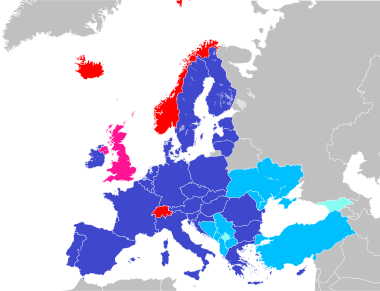
European integration is an ongoing process. There's always discussion about how much more Europe should unite. Some people want a "Federal Europe," like a single country, while others prefer countries to keep more of their independence.
Many countries in Eastern Europe are working to join the EU, like Albania, Ukraine, and Moldova. This helps them grow their economies and become more democratic.
Some countries, like Russia, Belarus, and Kazakhstan, have also formed their own group called the Eurasian Economic Union to work together economically. Sometimes, countries like Armenia try to work with both the EU and the Eurasian Union.
Beyond Europe: Global Connections
The EU also works with countries and regions all over the world.
- The Asia–Europe Meeting (ASEM) brings together leaders from Europe and Asia.
- The EU works with countries in Africa, the Caribbean, and the Pacific (ACP countries) to help with development and human rights.
- The Euro-Latin American Parliamentary Assembly (EuroLat) connects the EU with countries in Latin America.
European countries also have special ties with other nations around the world due to their history, like the Commonwealth of Nations (with the UK) or the Francophonie (with France).
Images for kids
See also
 In Spanish: Integración europea para niños
In Spanish: Integración europea para niños


